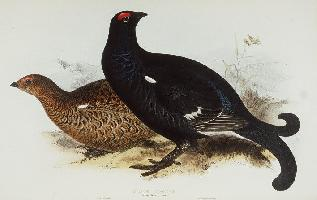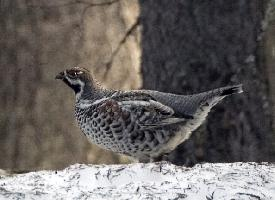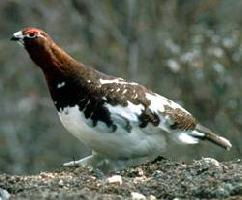
Description de l'animal
The Black Grouse, scientifically known as Lyrurus, represents a captivating genus of birds within the grouse family, renowned for its unique behaviors and striking appearance. This genus, primarily found in the Palearctic, including parts of Eurasia and the British Isles, consists of species that have adapted to a variety of habitats, ranging from dense forests to open moorlands. Among the notable species within this genus is the Black Grouse (Lyrurus tetrix), which is particularly celebrated for its intricate mating rituals and distinct sexual dimorphism.Physical Description:
The Black Grouse exhibits a remarkable difference in appearance between males and females, a phenomenon known as sexual dimorphism. Males, or "blackcocks", are larger and boast a lustrous black plumage with a distinctive lyre-shaped tail, which they fan out during their elaborate courtship displays. A striking white underwing and a bright red wattle above the eye further accentuate their appearance. Females, referred to as "greyhens", are more camouflaged with their mottled brown plumage, allowing them to blend seamlessly into their surroundings, an advantage when nesting on the ground.
Behavior and Ecology:
One of the most fascinating aspects of the Black Grouse's behavior is its lekking system, a complex mating ritual where males gather in open areas known as leks to perform competitive displays and vocalizations to attract females. These displays occur during the early morning hours at dawn, especially in the spring mating season. The males strut, jump, and make distinctive bubbling sounds, all in an effort to impress potential mates and establish dominance over rivals.
Black Grouse are omnivorous, with their diet varying seasonally. In the summer months, they feed on a wide variety of plant materials, including leaves, seeds, and berries, while in the winter, they rely more on the buds and twigs of trees such as birch and willow. The chicks, or "poults", are dependent on a high-protein diet of insects and other invertebrates during their early growth stages.
Conservation Status:
The Black Grouse is considered a species of conservation concern in several parts of its range. Habitat loss due to agricultural expansion, forestry practices, and urban development, along with predation and disturbances at lekking sites, have led to a decline in their populations. Conservation efforts are underway in many regions to protect and restore their habitats, manage predator populations, and minimize human disturbances, especially during the critical breeding season.
In conclusion, the Black Grouse of the genus Lyrurus is a symbol of the wild, untamed beauty of the Palearctic's forests and moorlands. With their dramatic mating displays, striking appearance, and complex behaviors, they captivate the interest of birdwatchers and conservationists alike. Efforts to preserve their habitats and mitigate threats are crucial to ensure that the mesmerizing lekking rituals of these iconic birds continue to grace the dawn chorus for generations to come.
Carte de répartition

Animaux similaires
Nouvelles photos d'animaux
Top 10 des animaux
- Dolphin gull (Leucophaeus scoresbii)
- Diana monkey (Cercopithecus diana)
- Moustached guenon (Cercopithecus cephus)
- Galápagos tortoise (Geochelone nigra complex)
- Japanese macaque (Macaca fuscata)
- Russian tortoise (Testudo horsfieldii)
- Stone loach (Barbatula barbatula)
- Greek tortoise (Testudo graeca)
- Common flying dragon (Draco volans)
- Vendace (Coregonus albula)


